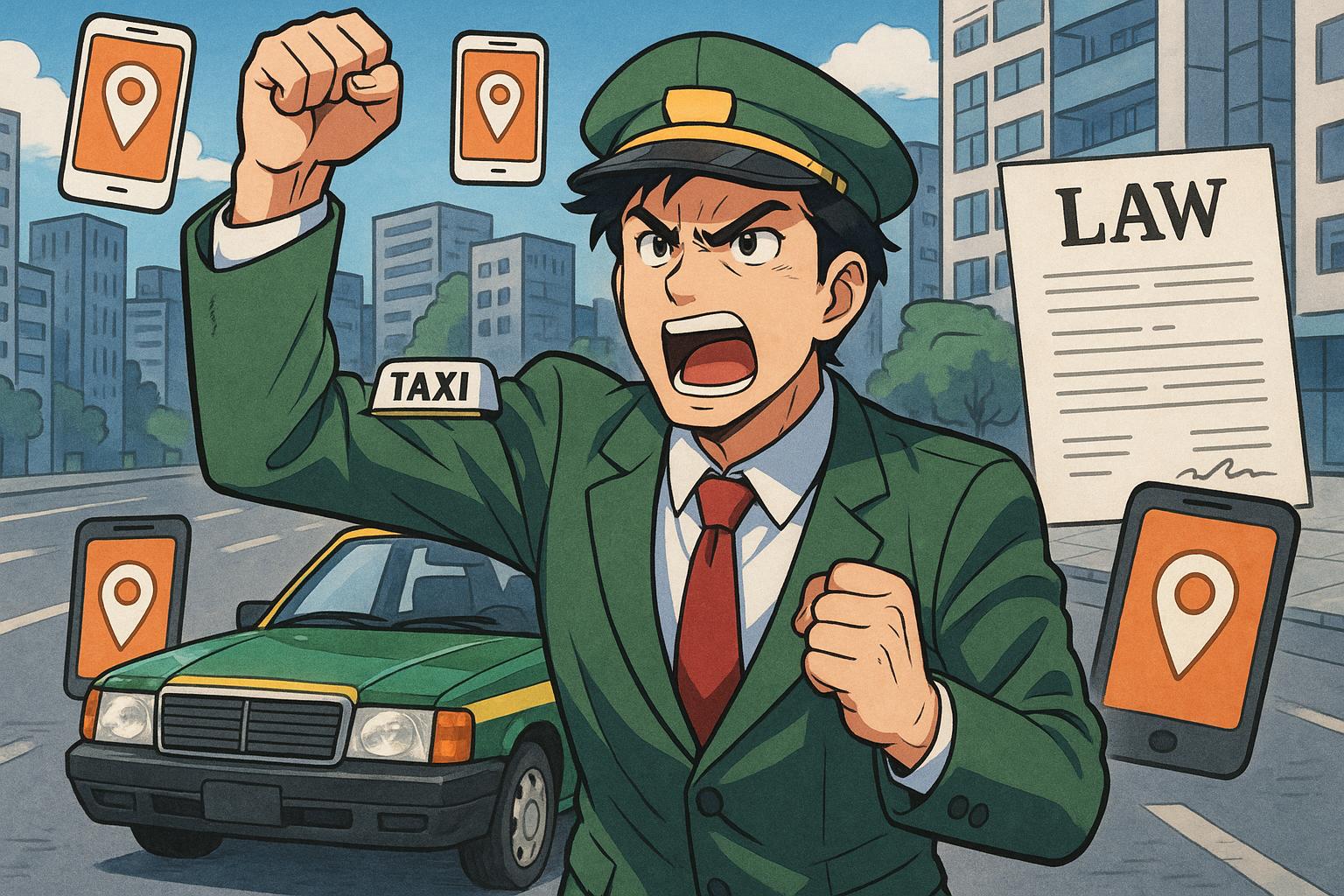From France’s UberPOP ban to Australia’s compensation scheme and the UK’s worker classification ruling, varied regulatory responses reveal the complex challenges of integrating app-based ride services with traditional transport sectors worldwide.
The emergence of ride-hailing apps such as Uber and Grab has prompted significant upheaval in traditional transport sectors worldwide. As nations grapple with this disruption, varying approaches to regulatory measures have emerged, revealing both the struggles and successes faced by governments and industry stakeholders.
In France, a prominent episode of conflict unfolded as traditional taxi drivers protested vigorously against Uber’s low-cost service, UberPOP, which enabled unlicensed drivers to operate. Major road blockades were organised, especially around Paris’s key transport hubs, leading to a decisive governmental response. The French Interior Ministry instituted a ban on UberPOP effective January 2015, following extensive demonstrations where thousands of taxi drivers demanded stricter regulations. This move reflected the government’s intent to level the playing field by mandating that all drivers adhere to uniform training and licensing standards. Moreover, legislation now restricts the number of vehicles for app-based services in certain areas, further aligning them with traditional taxi operations.
Australia’s handling of Uber’s incursion into the market stands in stark contrast, illustrating a more conciliatory approach. In New South Wales, the government recognised the impact of ride-hailing services on traditional taxi businesses, offering compensation of up to AUD 100,000 to those adversely affected by the market shift. This strategy aimed to mitigate the financial strain on taxi plate owners while establishing rigorous safety and insurance requirements for ride-hailing providers. The recent AU$272 million settlement in 2024, which resolved claims from about 8,000 taxi and hire car drivers, highlighted the ongoing complexities of these changes. Uber characterised some disputes as “legacy” issues from a time when regulatory frameworks did not adequately address the rise of ridesharing services.
Meanwhile, the United Kingdom set a significant legal precedent in 2021 with a Supreme Court ruling that classified Uber drivers as “workers,” thereby entitling them to minimum wage and other statutory benefits. This landmark judgement not only transformed the operational landscape for Uber in the UK but also sparked broader discussions regarding worker classification across the gig economy. Such legal definitions pose a challenge for regulators and companies alike, reflecting an increasing demand for fairer treatment in a landscape dominated by flexible work models.
Closer to home, Thailand’s Suvarnabhumi Airport has emerged as a focal point in the ongoing struggle between traditional taxi services and app-based transport operators. Local taxi drivers, facing rising operational costs stemming from vehicle financing, licensing, and insurance, have called on government agencies to take definitive action. While the Department of Land Transport and Airports of Thailand maintain that all transport services may coexist under a unified regulatory framework, the underlying tension reveals the complexity of achieving a balanced market.
Calls for justice from the traditional taxi industry include proposals for mandatory public driving licences, clear service markings, and equitable cost controls on insurance. These demands underscore the need for a nuanced approach to regulation, one that not only fosters innovation and competition but also safeguards the livelihoods of those already entrenched in the ecosystem.
Globally, the lessons learned from these national case studies suggest that no one-size-fits-all solution exists. As countries strive to carve out balanced frameworks that embrace technological advancements while preserving fairness, the goal remains to foster sustainable growth within the transportation sector. Establishing such regulations is essential, not merely for the stability of transport networks but to ensure that all sectors can adapt and thrive in an ever-evolving landscape of consumer choice.
Source: Noah Wire Services
- https://www.nationthailand.com/business/economy/40050382 – Please view link – unable to able to access data
- https://www.nationthailand.com/business/economy/40050382 – This article discusses how various countries are addressing the challenges posed by ride-hailing apps like Uber and Grab. It highlights France’s ban on UberPOP, Australia’s compensation to taxi plate owners, and the UK’s Supreme Court ruling classifying Uber drivers as ‘workers’. The piece also touches upon Thailand’s ongoing disputes at Suvarnabhumi Airport and the broader global context of balancing innovation with fairness in the transport sector.
- https://www.france24.com/en/20141215-france-paris-taxi-drivers-protest-uber-uberpop – In December 2014, France’s interior ministry announced a ban on UberPOP, Uber’s low-cost ride-sharing service, effective January 1, 2015. This decision followed significant protests from taxi drivers who blocked major roadways, including those leading to Paris’s main airports. The protests were in response to UberPOP’s operation, which allowed unlicensed private drivers to offer rides, challenging traditional taxi services.
- https://www.apnews.com/article/77a42a042f8d6fa550fb47533e46be98 – In March 2024, Uber agreed to a AU$272 million ($178 million) settlement to resolve a legal dispute with Australian taxi and hire car drivers who suffered financial losses due to Uber’s market entry in 2012. The class action lawsuit involved 8,000 drivers and was set to go to trial in the Supreme Court of Victoria. Uber characterized the issues as ‘legacy’ matters, noting that ridesharing regulations were non-existent when they began, but highlighted their significant contributions to state-level taxi compensation schemes since 2018.
- https://www.time.com/2854582/uber-protests-taxi-europe/ – In June 2014, over 30,000 taxi drivers across various European cities organized protests to pressure lawmakers into imposing stricter regulations on Uber. The protests aimed to address concerns that Uber drivers did not require the costly licenses that traditional taxi drivers did, which can cost approximately €200,000 ($270,000). Previous protests in Europe had turned violent, such as one in Paris which resulted in damaged vehicles.
- https://www.abc.net.au/news/2015-06-25/french-taxi-drivers-violently-protest-against-uber/6574114 – In June 2015, French taxi drivers protested against Uber by burning cars and blocking access to airports and train stations. Approximately 2,800 taxi drivers participated in the strike, with more than 30 blockades nationwide, including those leading to Paris’s Charles de Gaulle and Orly airports. The protests were in response to UberPOP, a service that connected customers with private drivers at lower prices than traditional taxis.
- https://www.time.com/3937262/hollande-uber-ban/ – In June 2015, French President François Hollande called for a crackdown on Uber following violent protests by taxi drivers against the UberPOP ride-sharing app. Thousands of taxi drivers protested, blocking access to major airports and train stations and setting vehicles on fire. Hollande condemned the violence but expressed understanding for the drivers’ frustrations, criticizing UberPOP for allowing untrained and uninsured drivers to provide rides and potentially evade taxes.
Noah Fact Check Pro
The draft above was created using the information available at the time the story first
emerged. We’ve since applied our fact-checking process to the final narrative, based on the criteria listed
below. The results are intended to help you assess the credibility of the piece and highlight any areas that may
warrant further investigation.
Freshness check
Score:
8
Notes:
The narrative presents a comprehensive overview of global responses to ride-hailing services, including France’s 2015 UberPOP ban, Australia’s 2024 settlement, and the UK’s 2021 Supreme Court ruling. These events are well-documented and have been reported by multiple reputable sources. The inclusion of recent developments, such as Thailand’s current challenges with ride-hailing services, adds freshness to the content. However, the foundational events discussed are not recent, with some dating back several years. The article appears to be a synthesis of existing information, with no indication of original reporting or new insights. Additionally, the article is published on a reputable news outlet, which typically ensures high freshness. Nonetheless, the lack of new information or perspectives suggests a lower freshness score.
Quotes check
Score:
7
Notes:
The article does not include any direct quotes. The absence of quotes may indicate a lack of original reporting or interviews, which could affect the originality and depth of the content.
Source reliability
Score:
9
Notes:
The narrative originates from a reputable news outlet, which is known for its journalistic standards and credibility. This enhances the reliability of the information presented.
Plausability check
Score:
8
Notes:
The claims made in the narrative are plausible and align with known events and developments in the ride-hailing industry. The inclusion of recent developments, such as Thailand’s current challenges with ride-hailing services, adds credibility to the content. However, the lack of new information or perspectives suggests that the article may be a synthesis of existing information, which could affect its originality.
Overall assessment
Verdict (FAIL, OPEN, PASS): OPEN
Confidence (LOW, MEDIUM, HIGH): MEDIUM
Summary:
The narrative provides a comprehensive overview of global responses to ride-hailing services, drawing from well-documented events and developments. While the source is reputable, the lack of direct quotes and original reporting suggests that the content may be a synthesis of existing information. The inclusion of recent developments adds freshness, but the foundational events discussed are not recent. Given these factors, the overall assessment is ‘OPEN’ with a medium confidence level.













